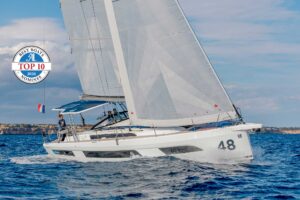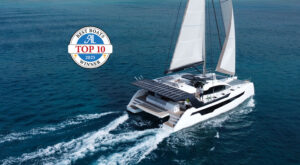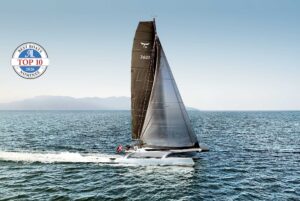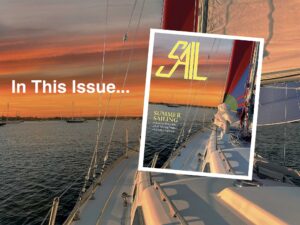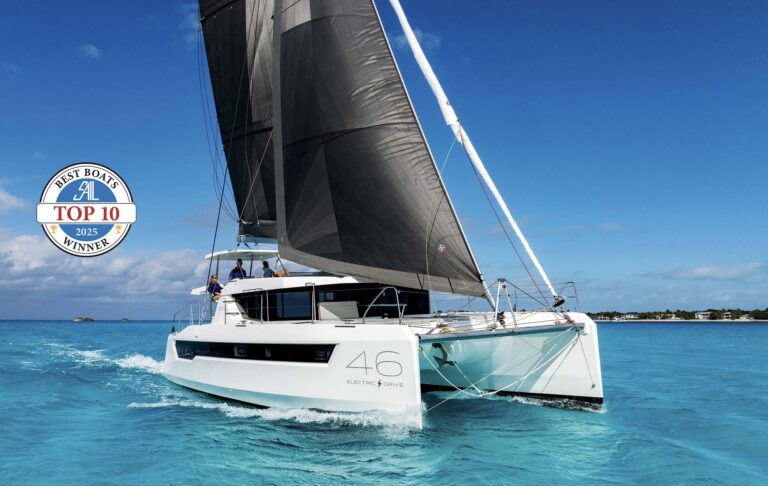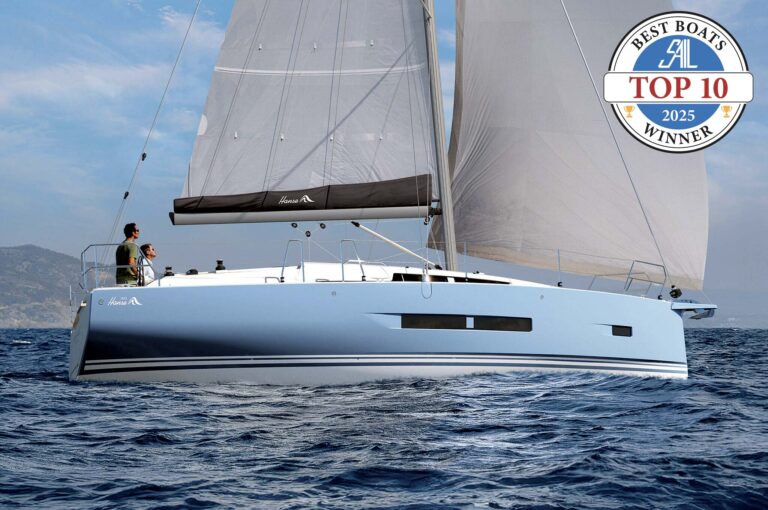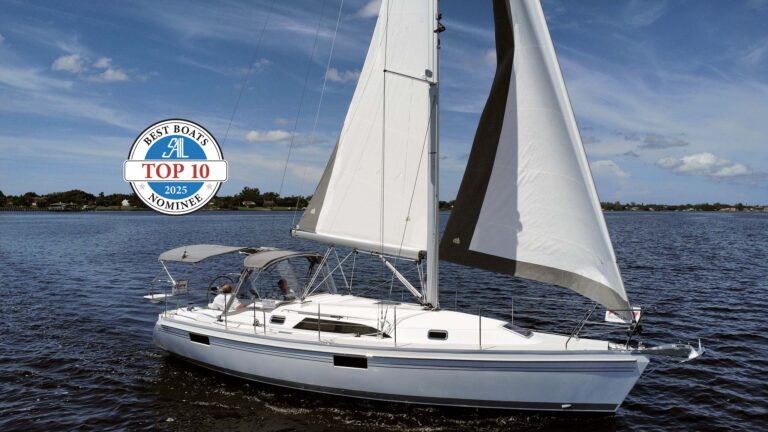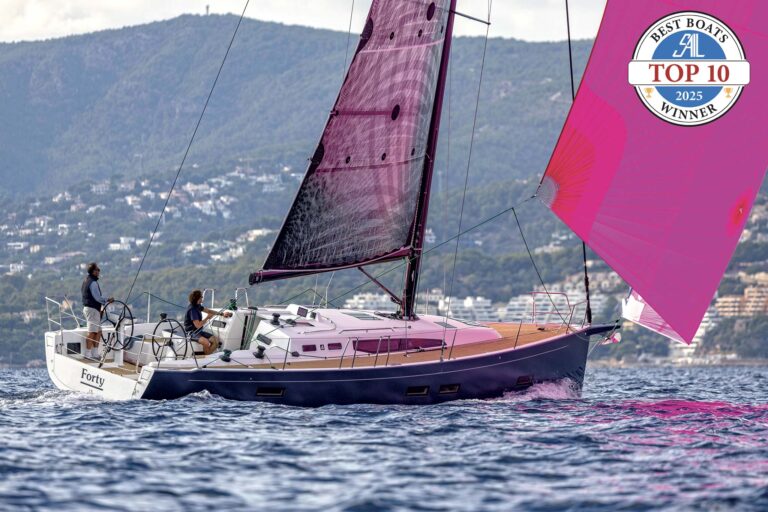
I had no trouble finding the new HH55 catamaran: she stands out in a marina of white plastic yachts like Hulk Hogan at a garden party. She is purposeful. No, purposeful is too wussy a word: she exudes menace. This is a cruising yacht, after all, that can knock off 250-mile days without even breathing hard.
DESIGN & CONSTRUCTION
From the design duo of Morelli & Melvin, who have created the cream of cats from America’s Cup winners to ocean-crossing record setters like Steve Fossett’s PlayStation, this is a yacht designed to get you somewhere, anywhere, fast and comfortably.
Whether you call them axe bows, reverse bows or wave-piercers, they give the HH55 a look of speed even at rest. This cat is far closer on the evolutionary chain to America’s Cup foiling catamarans than the plain vanilla cruising cats that fill the bareboat charter fleets.
Built by HH Yachts in China, which specializes in high-performance cats, the 55 raises the bar for construction standards, using female molds for minimum weight, a thermo-formed core to increase strength and 100 percent carbon composite sandwich construction with epoxy infusion. Additional carbon fiber can be found in highly loaded areas such as the chainplates and stringers, and the ring frames are carbon fiber as well. Sacrificial “false” bows add protection from collision, and watertight bulkheads seal off the bow and stern compartments. The floors are structural composites, as are the interior cored panels veneered with stone and fine woods. The intent, says Gino Morrelli, was to “kick it up a notch,” and they succeeded.
Underwater, the HH55 is no less sophisticated, with the latest generation curved C-foil daggerboards providing 15 percent of lift to the bow at 20 knots and rudders with T-winglets at their tips. Wave-piercing hulls have been criticized for burying, which can lead to pitchpoling, but the design team for the HH55 set the T-rudders at zero-degrees, so if the bows ever try to drop (or fly) the rudders will exert as much as one ton of force to counter the motion. The team also added “flats” to the bottom of the bow sections to add yet more lift and reduce pitching.
Of course, the positive side to reversed bows is a longer waterline and reduced foredeck weight, albeit at the expense of a wetter boat. The boards are in curved wells with bearings of Vesconite, a material that makes Teflon seem positively sticky.
ON DECK
Aloft, the huge 1,343ft mainsail is also quite unusual for cruising, from the square-top head that extends horizontally from the masthead to the wide slotted V-boom that serves to capture the sail after it’s dropped. Swept-back spreaders with Aramid upper and lower shrouds preclude the need for a backstay to support the furling double-headsail rig. The towering 88ft mast is made by Southern Spars, and at the base has the cluttered but purposeful look of a soldier heading for combat.
A big part of this complexity stems from the fact that the HH55 we tested has a forward cockpit for sail control, with two doors leading to it from the saloon. Three Lewmar 65 two-speeds provide the “oomph” for things like raising halyards. But because the lines can’t be led neatly aft (for example, on the cockpit sole as aboard many boats) the buck stops at the base of the mast, along with plenty of stoppers, turning blocks, fairleads and a whole lot of other stuff. Until one gets used to the layout, have a road map handy.
That said, the HH55 is offered with two deck layouts: one with twin wheels aft on raised consoles, the other with a single forward helm, as on our test boat. I like the inside helm (an opening sunroof provides a clear view of the sails) because the aft helms seem exposed for shorthanded cruisers. However, I fear that the forward cockpit is going to be uninhabitable when the spray is flying. Your call.
Again, the fully battened main drops neatly into a V-boom, led by lazyjacks from near the end of the sweptback spreaders (since fathead mains don’t like narrow lazyjacks). A self-tacking 446ft jib is on a furler, as is the 2,032ft reacher, which is an absolute giggle off the wind. Both the longeron (fore-strut) and the cross beam are, of course, carbon fiber, and also built by Southern Spars. With Aramid standing rigging there are no turnbuckles, so the rig is adjusted with a built-in mast jack.

ACCOMMODATIONS
The standard plans offer either three-cabin (port hull as master-suite) or four-cabin layouts. However, HH is quite clear that owners should pencil in their own design. In the case of our test boat, Minnehaha (hull #1), owners Deb and Doug went with a master stateroom to port, an aft guest stateroom with direct access to a head/large shower stall, and a forward stateroom to starboard. However, they also converted what would have been the head for the latter into a workshop, a good solution for cruisers. While the hulls are slim (waterline beam for each is just under 5ft), the master suite in this layout is still large enough to include a hidden washer/dryer and numerous lockers.
The saloon is where owners can, and should, wield the pencil most creatively, since the standard layout fills the starboard side with the galley, leaving only fore-and-aft basic bench seating to port like a subway car. Deb improved this by adding an L-shaped settee to create a conversation area, and also opted for what everyone started calling the “Thanksgiving Table,” a table that starts inside the saloon, but which, with a filler leaf, can join to the cockpit table when the sliding doors are fully open to seat just about everyone in the anchorage.
The nav station is forward to port, and there is a counter to starboard and two doors to tend the sails.
UNDER SAIL
Yee-haw! Let’s cut to the chase here: we were doing a steady 8 to 9 knots upwind in 8 to 9 knots of true wind, and 10 to 11 with the reacher in, yes, 11 knots of wind. Really. And that was through some Gulf Stream chop that the hulls didn’t even notice. Morelli says she can sail as high as 45 degrees, but 48 degrees is where she really romps. I found the torque tube steering a bit stiff. But she responded quickly, and in spite of turning a 27ft beam, she remained quite nimble, so that you can work her to windward like a monohull.
UNDER POWER
Twin Yanmar 57hp diesels with SD60 saildrives and three-bladed Gori folding props shove the HH55 along at 12 knots on both engines or 6.5 knots on just one. Minnehaha had the optional Quick retractable electric bow thruster on the starboard side, which was invaluable when planting this 55-by-27ft package into its slip.
CONCLUSION
With its complicated rigging, tall sailplan and daggerboards that must be raised and lowered on each tack, the HH55 isn’t for the cruiser who wants two winches, a self-steering vane and a case of Corona. On the other hand, this is a technically impeccable yacht through-and-through, and, gee, the opportunity for daily runs of 250-plus miles sure is a powerful aphrodisiac.

Specifications
LOA 54ft 6in LWL 54ft 6in BEAM 27ft
DRAFT 4ft 11in (boards up); 10ft 11in (down) DISPLACEMENT (light ship) 30,864lb
SAIL AREA 1,789ft (main and blade jib)
AiR draft 88ft 3in
FUEL/WATER (GAL) 185/127
ENGINES Twin Yanmar 57hp with saildrives
SA/D RATIO 30 D/L RATIO 85 (light ship)
What do these ratios mean? Visit sailmagazine.com/ratios
DESIGNER Morelli & Melvin Design
BUILDER Hudson Yacht Marine, Quanzhou, China, hhcatamarans.com
U.S. DISTRIBUTOR Hudson Yacht Group, Jupiter, FL, [email protected]
PRICE $2.4 million (base)
November 2017

